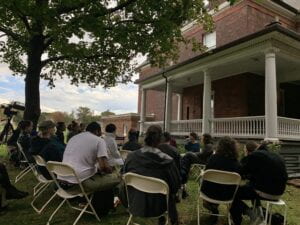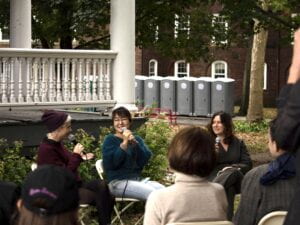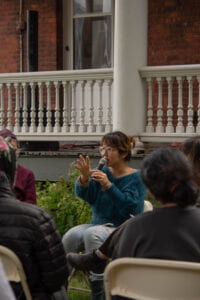
A soft amber light broke through the looming storm clouds as visitors settled into their seats under the shade of a large tree adjacent to the WetLab’s porch. Visitors made their way via ferry to Governors Island on October 30th to listen to Contretemps. artists Jemila MacEwan and Hanae Utamura discuss the relationships integral to their artistic processes, and how they use art as a means to facilitate deeper and more mindful connections across species and geological forms. The discussion was moderated by Eugenia Kisin, co-director of the WetLab and NYU Gallatin faculty.
Both Utamura and MacEwan’s work in the show as well as in their larger art practices focus on the intermingling of the self, the imagination, and the natural. Utamura is a Japanese interdisciplinary artist based in New York whose work focuses on facilitating relations and negotiating conflicts between the human and non-human entities of Earth. Utamura’s work in Contretemps., “Ancient Air – Seafloor Core Glass Volcanic Moment,” specifically mimics natural glass making processes by placing ancient ocean floor sediments in hot glass and observing how these sediments react as the form solidifies around them. The result preserves the ancient air caught in the sediments in a dynamic motion, placing it in action until the glass is shattered, not unlike the bugs caught in golden amber. MacEwan’s work, too, highlights and personifies the natural world. An interdisciplinary artist based in New York, MacEwan’s work curates its own contemporary mythological figures out of the natural world in order to highlight humanity’s increasing destruction to the earth and the uncertainty that lies ahead as a product of this behavior. Their piece in the show, “Dead Gods,” is a living mycelium monument honoring the prehistoric fungi that were the origins of life on earth. This piece also serves to highlight the precarity of the species we are familiar with today and the rising rates of extinction.
The conversation between Utamura and MacEwan dissected various important topics within their works, including ritual, performance, care, vulnerability, and responsibility. Both artists spoke on the significance of these concepts in their work, specifically highlighting how a heightened awareness of self and the world around them allows them to participate in a notion of culture that is beyond humanity. MacEwan describes this as ecomorphism, in which they allow that which is not human to imprint onto them and transform how they are.
MacEwan describes ritual in their work as, “As you are listening, they are listening too, and there is this two-way conversation that happens there. And so where ritual comes into that is that I think about ritual as the kind of art that humans make that also everyone else makes too. So the changing seasons, the fact that we’re in fall now, That is us witnessing the ritual of life day tonight, these things. So when we participate in ritual, that’s us participating in a notion of culture that actually extends beyond the human.”
While Utamura’s understanding of ritual in her work also stems from a place of communicating with non-human entities in a way that defies language, she also describes how ritual stems from a foundation in childhood play. She describes her days as a child when she would engage in ritual with the natural world around her, creating a bond between herself and these entities without knowing the proper terms for these actions.
“I always somehow had this habit of secret places. I have a spot where I would have. And without knowing this word, ritual or animism, I always had conversations with the place actually, and when I recall, I would also do like some kind of like a gesture, a performance. I didn’t know these words, but I would rotate, I would do some gestures. And also, I would have objects and animals. And those were kind of my friends…And somehow I think what I do now is also an extension of that. Like those conversations that I used to have that didn’t even involve language. But I think like art has a place where a kind of certain visual vocabularies, or not even visual, but you can develop your own vocabulary and give a life to it and also give a presence to these tiny things that we don’t even pay attention to every day, because we’re so busy with information,” said Utamura.
Both artists spoke on how these deep ritualistic connections with the natural world intensify the spirituality of their work, as well as the emotions they experience while creating the work, and thus care for self and for the participating parties is integral to their artmaking practices.
MacEwan said, “When these issues, these catastrophic events are so large and there’s so much need for care, [people are] not actually able to transform that care into anything intimate. So if you’re reading the news a lot, or if you’re just overwhelmed by this big thing, it’s overwhelming and you get kind of crushed by it. So I do make work in which I find a way to intercept that need for care. And we do it in a way by making it very specific. So it’s not caring about everything all at once. Because that’s ineffective. It needs to be so focused and care is really only functional if it is deep and focused and intentional. And I think that what happens when you take in too much, there’s this feeling like, oh, it’s, it’s impossible… Small intentional specific actions of care that run long are actually where transformation is possible. And actually, that transformation is exponential. When you work with land and you invest that care and ritual into the land, what happens is that you’re not the only one out there. You change the psychic zone of that land. And you’re not the only one taking care. Suddenly the sky is taking care. The birds are taking care of the insects, the grass, and you realize everyone’s taking care. I think that is almost like a cure for the depression or overwhelming [feelings].”
MacEwan also discussed how this sense of care is reflected in their “Dead Gods” piece in the WetLab exhibition. While the mycelium sculptures required an intense amount of care and monitoring to ensure their growth, this intense care also bore bountiful harvests of mushrooms, which were then shared with the community on the island to eat. In this way, there is a reciprocal sense of care between artist and work that stems from a deeper understanding of the other’s needs.
Utamura discussed how her own work also echoed this sense of care, but through a new lens of motherhood. Utamura described how she became pregnant during the pandemic, and thus had a greater consciousness for how the simple act of breathing had the power to continue or end the life she was growing. This meditation on connectedness and selfless care led her to consider how life on Earth and human’s relationship with the natural world mimics the relationship of motherhood and breath.
“And I just started to feel like, ah, this is how we are. Earth and us. I just felt like I want to give it a form, [it is so] significant and yet invisible like we don’t see this breathing. I made those glasses with the sediments [previously], but I just wanted [remake them], to give this moment of creating a situation of how my breaths would interact with the ancient air or ancient breath. And then somehow, [while making the glass], there was a moment of touch, this breath, this space that was created within the glass was touching with growing breaths in the sediment and somehow it’s solidified like that. It’s solidified like this touching moment. And to me, that was learning from the very situation that I offer. The nice thing about this preservation of the form is then it can be shared.”
This idea of care in their work also brings up conversations around vulnerability—how does one surrender themselves to the piece and allow it to transform them, even if this is painful? Both MacEwan and Utamura believe that vulnerability is integral to their work and that an overwhelming sense of care allows for this vulnerability.
“Art for me is to be a student of the world and also to be transformed. And you can’t really be transformed unless you are surrendering, you are relinquishing control. So it’s trusting, and the core of it all is love. So if there is not the deep intention of love, then you would basically have something that is corrupt. So, I take vulnerability very seriously. It’s essential, but it’s super hard. Being willing to enter that space of way of love is fraught with a lot of pain and you have to be willing to face that pain when it arises, but ultimately every time you’re cracked open, you feel more whole. I think shutting it out is going in the other direction into depression. So even though it’s painful, it’s the thing that transforms you. And then it also is the thing that connects you to more,” said MacEwan.
The conversation concluded with questions from the audience and thunderous applause for MacEwan and Utamura. Although the exhibition in which these artists’ works were exhibited is now closed, more information on their works and the exhibition can be found on the WetLab website.

Above: Artists Jemila MacEwan (left) and Hanae Utamura (center) with moderator and co-director of the WetLab Eugenia Kisin (right).
Below: Utamura discussing the influences of ritual and animism in her work.

